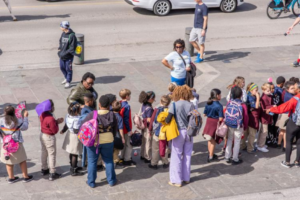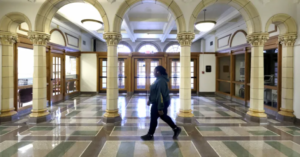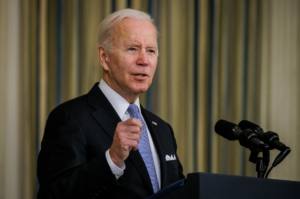Bucking metro area trends, Mapleton schools grow by attracting out-of-district students
6 min read
When Jennifer Velez was unhappy with her kids’ schools, she didn’t know that in Colorado she could take them across district boundaries.
Then, a friend who was coaching her son’s youth football team said he was moving his son to Mapleton. If she sent her son, too, the kids would at least have each other in the new school. She was convinced.
“It was super easy,” Velez said. The Mapleton school was only four miles from her home in the Adams 12 district. “I thought, if it doesn’t work, I can always move him back to our district.”
But she liked the new Mapleton schools, and a year later, she moved her daughter there, too. Mapleton Public Schools, a district of almost 9,000 students north of Denver, every year attracts thousands of families like Velez’s who cross district boundaries to send their kids to schools there.
Their choices have helped keep up Mapleton’s enrollment during a time when most other metro area districts are losing students. Colorado’s open enrollment system allows parents to enroll their children in any district that has room for them. Mapleton has taken advantage of that system, sometimes referring to itself as a “destination district” with small, specialized schools tailored to students’ needs. The district provides transportation to all students once within the district boundaries, removing part of the barrier that limits parents’ ability to exercise school choice in other districts. Mapleton also builds schools near its boundaries with other districts and operates an online school that enrolls students from around the state.
Among 15 metro area districts, the only other district with an upward enrollment trend over the last five years is the Brighton-based School District 27J where development is booming. Maintaining or growing enrollment helps districts avoid budget cuts as Colorado’s school funding is tied to student counts.
Even in the last year, when most districts saw large pandemic-related declines, the district’s official student count only dropped by nine students while the number of students who chose to come into the district from outside saw a significant jump, according to a Chalkbeat analysis of state data.
In the 2020-21 school year, about half of Mapleton’s students came from other districts. Excluding Colorado Connections Academy, Mapleton’s online academy which takes students from across the state, district data shows that more than a third of the district’s students are choice enrollments from outside the district. That’s a higher proportion than for any other metro area district.
Mapleton’s out-of-district enrollment numbers grew by 1,600 students in 2020 to 4,521; Colorado Connections Academy grew by 258 students.
“We maintained our normal trajectory,” said Superintendent Charlotte Ciancio. “We’ve had steady growth.”
Mapleton is a unique district because it is an all-choice district. It has several specialized small schools, but does not assign students to any of them based on where they live. Instead, families choose the school that suits them best. The district provides transportation through a shuttle system so students can walk to their closest school and take the bus to any school in the district. Some of this works because of the district’s size.
“When parents make a deliberate and intentional choice,” Ciancio said, “they are more committed to the success of our schools.”
District officials credit the district’s geographic location as one of the biggest reasons for enrollment from outside the district. Mapleton has uneven boundaries that don’t match city or county boundaries. Mapleton schools have Thornton and Denver addresses. For some families that live in the Westminster or Adams 12 district boundaries, Mapleton schools can be closer than their own district’s neighborhood school.
The majority of Mapleton’s out-of-district students come from the Adams 12, Adams 14, and Westminster districts that border it. Those communities are generally similar — working class suburbs, with a high percentage of Hispanic families — but the districts also have pockets of more affluent neighborhoods.
Other factors that may play a role include Mapleton’s 100% choice culture, the transportation shuttle system that allows out-of-district students to catch the bus from one of the district’s existing stops, and new school construction. In the past, the district has also marketed in certain areas.
One of Mapleton’s newest schools, Explore Prek-8, sits near the intersection of York and E. 104th streets, on the edge of Mapleton’s boundary with Adams 12.
Mapleton board member Cindy Croisant said that at the school’s opening, she met parents who were from just across the street and interested in the new Mapleton school.
But, she said, it wasn’t planned that way.
“What we thought about was the community we were serving,” Croisant said. Board members heard from community members who said they wanted a school in that area, she said.
Recruiting students from other districts is rare, but not prohibited by law.
Croisant emphasizes that the board’s goal, despite sometimes using the phrase “destination district” to describe Mapleton, is to be welcoming and to be a model for others.
“The ‘why’ behind the work was about our students, and keeping our students because we had students leaving the district back then,” Croisant said. “We want to stay a small-schools-by-design district.”
Ciancio said she still would like to improve academics to help make Mapleton a better, and more attractive district. “We have everything else in place,” she said.
Parker Baxter, the director of the Center for Education Policy Analysis at the University of Colorado Denver, has studied choice more generally and believes that another factor is the legal ability to make the choice, along with a possible higher awareness of that ability in the Mapleton communities.
“Just the district’s attitude can be playing a role, but it’s hard to measure that, ” Baxter said. “The difference between a district that’s open to choice and one that literally does not advertise it at all, is really significant. That Mapleton outwardly promotes its schools outside of its community and purposefully talks about them as open enrollment schools, that likely plays a role.”
Relying on out-of-district enrollments can also be considered risky for district leaders, Baxter said. It can make tracking enrollment more challenging, as those families can suddenly pull out. If they are already making sacrifices to make the drive, schedule changes or other life changes might make the situation too difficult. In other districts, promoting choice can be a political risk as some people are opposed to choice and its effects on schools.
Ciancio said Mapleton has not spent money on advertising its schools lately, but said that when they do send mailers, they go to zip codes that are part of the district, except because boundaries don’t line up, some of the homes that receive Mapleton materials are actually outside the district’s boundaries.
In 2019, Mapleton did spend money to specifically let Adams 14 families know that they would get preferential enrollment that year. Ciancio said she believes most families that find Mapleton do so through word of mouth.
For Jennifer Trujillo who lives in the Adams 14 district and has two daughters in Mapleton schools, that was the case. And, distance wasn’t a factor. Her district school is just two blocks away, but she chose to drive the eight miles to a Mapleton school.
Her oldest daughter, Isabella, was in third grade, and despite having tested as gifted since preschool, had not been given any different accommodations, Trujillo said. She wasn’t being challenged.
“They asked me if I wanted to skip her from preschool to first grade, and I said that’s a little much,” Trujillo said. “They said OK, so they just kept her in regular classes. When I put her in Mapleton, it took her one time to test and they put her in the [gifted] program.”
Trujillo, who was a single mom, said she found a way to make the drive work, and Mapleton helped. Before the pandemic, she dropped her daughters at one of the district buildings where they participated in choir and band as part of an early morning “zero hour.” Mapleton then put the girls on buses to each of their schools.
Isabella just graduated and is heading to the School of Mines in a couple of weeks with a full scholarship.
“It was a conscious choice I made,” Trujillo said. “I just really wanted them to be in a quality school and to give them the best I can.”
This article was originally posted on Bucking metro area trends, Mapleton schools grow by attracting out-of-district students







